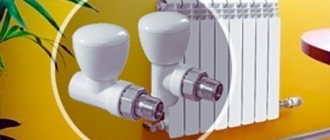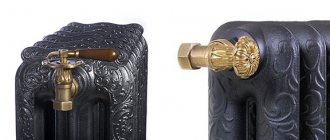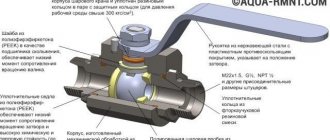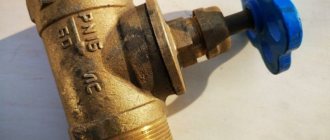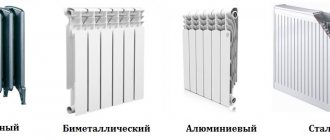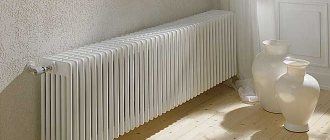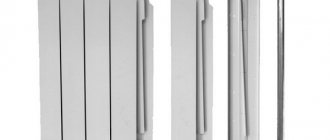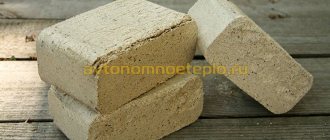One of the most necessary devices in any private or multi-storey house is heating radiators. They warm up rooms during the cold season, creating a comfortable microclimate in each room. When replacing a battery, it is necessary to determine not only its type, installation method and connection to pipes, but also the installation of additional technical elements. Such elements include valves, valves and specialized taps for heating radiators.
Which taps for heating radiators to choose
Technical features of radiator taps
Valves for heating radiators are valves installed on heating pipes and serving as a shut-off system. Their main feature is to block the access of hot liquid to the battery.
Therefore, if the heating system malfunctions, there is no need to contact the housing and utility company to troubleshoot the problem. When the tap is closed, the water will not flow into the radiator itself, but will pass further along the pipe through the built-in jumper. The radiator will remain without liquid, which will provide conditions for its installation.
- Such devices are ideal for private households.
- If one of the batteries malfunctions, it will be enough to close the valve on it.
- At the same time, other radiators will continue to operate and the temperature in other rooms will not be affected.
Also, this feature of heating taps will help save the family budget; non-residential premises can be turned off from heating by turning off the tap on the radiator.
Valve
The most common type of tap is a valve. Allows you to regulate the pressure. The flow channel inside it is perpendicular to the flow of liquid in the supply pipes. Installation must be carried out with careful attention to the markings so that water flows only in one direction.
For heating systems there are valves with a conical valve. They are most effective for such conditions. Fully open, it allows the maximum amount of liquid to pass through, which makes the thermal output of the battery more efficient. The mechanism allows you to reduce the flow of coolant and reduce heat transfer if the room is too hot and, thus, control the temperature.
There are these types:
- adjusting (straight and angular). They have manual control. Used in autonomous heating. They cannot accurately adjust heat transfer due to the lack of a scale and temperature sensor;
- equipped with a thermal head. Their design allows the temperature rise to be blocked or limited through manual or automatic control. Installed on two- and one-pipe systems. Adjustment is simple - the required temperature is set manually using a limit ring;
- with thermostat. Installed in front of the battery. The flow of coolant is controlled by a tap mounted in front of the thermostat.
There are no valve taps made of plastic; they are made from brass, steel or a combination of these materials.
Application
Valves on radiators are necessary primarily to shut off the liquid in them. Those. they serve as a locking system.
This gives them the following functionality:
- Turn off the heating system as needed;
- Shutting off the fluid in the system to carry out repair and maintenance work on the heating system;
- Regulation of air temperature depending on the preferences of the owner of the premises.
Often such cases occur in apartment buildings, when it is warm outside, but the heating has not been turned off or gas meters are installed throughout the entire building. Then it turns out, according to the colloquial expression, “they are drowning the street.”
The solution to this problem will also be a faucet on the radiator, which will help create not only a comfortable temperature in the room, but also save money.
Specifics of various cranes
The market offers two types of taps, starting with an automatic device and ending with equipment with thermal heads. Each of them has its own specific work.
Manual adjustable taps or valves of automatic devices are equipped with thermal heads, which allows you to save energy during the heating season. This is achieved due to constant air temperature in the rooms.
Moreover, the manual taps are designed in such a way that before the start of the heating season, it is possible to adjust the coolant according to one system, which will not allow the coolant to exceed the established norm.
As for valves equipped with thermal heads, where the fluid flow is automatically regulated. Due to this, the flow area in the heating system is reduced or increased, depending directly on the temperature in the room.
What to consider when installing taps
When installing various taps, it is necessary to take into account, firstly, personal preferences, that is, whether you want to overpay for more precise temperature control, and secondly, the parameters of the room, house, and so on.
The instructions for installing shut-off valves of various types are very similar to each other. It is imperative to check everything for leaks in order to avoid accidents; you also need to take into account the convenience of using such devices. You shouldn’t waste money on a seal; it’s better to choose trusted manufacturers.
If you do not understand anything about installing shut-off valves, then it is better to consult with a professional about what type of faucet you should install in your home.
Installation nuances
Taps for heating radiators are used in the following cases:
- For central heating systems;
- For private housing construction and apartment buildings equipped with an individual heat source;
- For apartment buildings that belong to an individual boiler room.
Before installing valves or taps, you need to know that these devices block the cross-section of the pipe. Therefore, any regulation using these devices will reduce the heat supply to the radiators.
If there is not enough thermal energy, regulation of the battery taps is not necessary. This will only lead to cooling of the air in the room. Here, one option is to block the entire flow.
If the house is heated by a central boiler room, then it is recommended to install brass taps on the radiators. Valves with thermal heads will not help in this case, but will only clog the coolant control.
Then the only solution is high-quality installation of heating radiators. Also, with centralized heating, pressure surges and water hammer occur, which are caused by the startup of the heating system.
Therefore, it is recommended to install ball valves on radiators, which are designed for pressures of more than 16 bar. As for the material itself for making valves or taps, it is advised to purchase a product made from high-quality metals that will withstand any force of corrosion.
Types of taps and materials from which they are made
There is no clear answer to the question of which taps are best installed on heating radiators. They differ from each other not only in price, but also in the material of manufacture, method of fastening and functions performed.
All cranes are divided into two groups:
- Shut-off or adjusting.
- Thermoregulating.
Shut-off devices are designed to control water flow. The shape of control valves for heating radiators can be angular or straight. With their help, you can repair or clean any battery without shutting down the entire system.
Straight radiator tap
Corner radiator tap
The most important thing when choosing the material from which the device is made is to pay attention to its resistance to corrosion. The method of fastening also depends on the type of material. Most often, taps are made of synthetic brass. Such products are attached to metal or plastic pipes using threads or plumbing fittings.
Threaded fittings made of chrome plated brass.
Devices made from high-quality polypropylene are very popular. They can be coated with metal coating on top. How to install such a tap on a radiator? To do this you will have to use welding. The main disadvantage is the impossibility of replacing the valve without cutting out part of the system.
In plumbing stores you sometimes come across cheap fakes made from silumin (an alloy of aluminum and silicon). Externally, this material is similar to brass, but is susceptible to corrosion and quickly rots.
Ball Valves
This type of device is the simplest and most common. It is designed to shut off and open the heat supply. It can only be in two positions - open and closed. If desired, it can be installed in an intermediate position. In this case, its wear will increase many times.
Ball valve
The flow of liquid is blocked by a metal ball, which changes its position by moving the handle. The components of this tap are usually made of bronze (steel, brass). To seal the connections, fluoroplastic gaskets are used. If desired, you can replace them yourself. The valve is connected to the radiator using a nut or an “American” (a quick-release connection consisting of two mating threaded ends and a union nut).
“American” for mounting the valve
Which ball valves are better? Experts recommend purchasing devices made of brass. They are more durable and wear-resistant.
Modern ball valves are manufactured using the latest technologies. Metal balls are carefully polished. The smoother the ball, the less likely it is that hot water will leak through it. In addition, a smooth ball is easier to turn, which means it is more convenient to use.
Ball valve design.
By capacity, ball devices are divided into:
- standard (pass 70-80% of the water flow);
- full bore (pass the entire fluid flow).
In order not to reduce operating efficiency, it is recommended to install a full-bore valve on the heating radiator.
Ball valves are divided into flanged, coupling and welded. Radiators use exclusively coupling models. The remaining two types are not suitable for use in private houses and apartments. Flange devices, for example, are installed on pipelines. They are strong, durable, and can withstand high pressure.
Union ball valve
When purchasing a ball device, you need to take into account the type of pipes with which the connection will take place, their diameter (in millimeters or inches) and operating pressure. Valves come with internal and external threads, with crimp and union nuts.
If you plan to install only ball valves, then they are mounted on two pipes (supplying water and draining it) right at the inlet (outlet) of the radiator.
Cone valves
Such devices operate smoothly, unlike ball-type ones. With their help you can regulate the flow of hot water. The cone valve consists of a handle and a cone threaded rod. When you turn the handle, the rod begins to move along the thread, gradually opening or closing the access of the liquid. In the lowest position, the rod completely blocks the flow of water. Elastic gaskets located in the annular grooves of the rod ensure tightness.
Angle cone radiator valve
Typically, plug valves are made from brass or bronze. But budget models are made of polypropylene. They are not durable, so they are used in systems where some of the pipes are made of plastic.
Mayevsky crane
The needle valve (Mayevsky valve) is responsible for removing air from the system, which gets there along with water (antifreeze). Air lock reduces heating efficiency. The accumulated air rises and collects at the highest point of the radiator. That is why the Mayevsky tap is located on the top of the battery on the opposite side of the inlet pipe.
Mayevsky crane
Mayevsky's device opens and closes by turning a screwdriver or a specialized key. It is recommended to choose a model that can be turned with a screwdriver: the key is easily lost. To open, turn the valve on the radiator counterclockwise until the hiss of escaping air is heard. After the hissing stops, screw the valve back on.
The Mayevsky tap has a small throughput capacity, so it is only suitable for modern radiators made of steel or aluminum. To get rid of air accumulated in a cast iron battery, you need a valve that allows you to drain a large amount of liquid.
Attention! To bleed air from a system to which pumping equipment is connected, you must first turn off the pump. Otherwise, water will flow out of the hole under pressure, which can lead to a flood.
The Mayevsky tap is installed on the top of the radiator
The classic Mayevsky faucet is a mechanical air vent. Automatic ones are also available for sale. Among them are both large-sized models designed for installation in autonomous heating systems, and compact ones suitable for small room radiators. They work without human intervention, open themselves if air accumulates, and close.
Automatic corner air vent
Thermostatic taps
Faucets of this type are capable of automatically controlling the flow of liquid and maintaining a comfortable temperature in the room. The main structural component of the device is the siphon, located in the handle. It is a container with gas or liquid. When the temperature rises, the gas (liquid) in the siphon expands, puts pressure on the rod, which lowers and gradually blocks the access of water to the battery. As the temperature drops, the rod rises, increasing fluid flow.
Thermostat for heating manufactured by Danfoss
Although the price of thermostatic valves filled with gas and liquid is almost the same. They are slightly different in their functioning. Gas models are distinguished by their rapid response to temperature changes, while liquid models act more accurately on hot flow.
Electronic thermostat on radiator
Depending on the type of thermostatic valve, the initial setting of parameters occurs: by rotating a mechanical knob or by setting the required values on a more visual digital screen.
Variety
These devices have significant differences from each other.
Device types:
- Ball equipment. Serves the battery without shutting down the entire heating system. The shut-off fittings are located between the pipe and the radiator. The equipment is made of metal, which includes a body part, a handle and a couple of pipe sections. The peculiarity of the device is that the faucet closes and opens the equipment. It does not apply to temperature control;
- Cone devices. They are manual control of the radiator temperature. The faucet is a metal body part equipped with a handle. The peculiarity of the device is that it reduces the heating of the radiator. The downside of the faucet is periodic cleaning of the device from deposits;
- Mayevsky's device. Used to reduce accumulated air and gas in the battery. It is a plug with a metal thread and a hole through which air and gas escape. These devices are ideal for radiators made of aluminum, because it is this metal that accumulates air and gases the most (they are removed once a month);
- Thermostatic taps. Represented by an automatic device. The valve consists of a cylinder filled with liquid and gas. The device itself has a temperature regulator that allows you to maintain a constant temperature in the room. Important! A radiator with such a device provides a bypass.
Installation and connection of a valve for a radiator for heating
Depending on the layout of the heating system, hot water supply pipes to the radiator are supplied in different ways, and, accordingly, plugs and control valves are installed in different places. Before installation, it is necessary to shut off the coolant supply to the heating battery and drain the water.
If a single pipe system is used. where hot water flows through one pipe and heating devices are connected in series, a pipe enters the upper part of the battery and supplies coolant. It passes through the installation, exits from below on the same side and goes into the main line. In this case, the thermostat is installed on the bypass - pipe jumper. This jumper connects the forward and return pipes of the heating device and allows hot water to move after the pressure is blocked by the valve.
You can make a jumper with your own hands by welding a small diameter pipe (up to 8 cm) to steel pipes, having previously prepared the holes in the right places.
On a two-pipe system. where there is one pipe for the influx of coolant, and another for the outlet, there is no need to install a jumper; the thermostat is mounted on the water supply pipe.
Installing a radiator control valve is especially effective in an individual heating system, but in a centralized heating system it also gives a significant saving effect, provided that there is a hot water meter.
Shape of taps
The devices are available in two types - angle and straight valves.
Direct device
A straight faucet delays the flow of coolant, reducing the cross section. At the same time, the throughput capacity is reduced by half compared to a pipe of this cross-section.
Angle valve for radiator
The device is located on the battery at an angle of 90 C. The throughput of the crane compared to the above-mentioned brother is increased a couple of times. All this is justified by the fact that the raised spool does not block the flow area of the device.
Radiator installation
Let's figure out how to properly hang the battery with your own hands. Regardless of the type of radiators chosen, before installing them, you should carefully prepare the installation site. Very often, batteries are installed under windows to provide the necessary air convection.
When making a major renovation of a private house or apartment, the external walls are often insulated and the internal walls are sheathed with plasterboard. Before insulation, metal frames are installed. In this case, before installing new batteries, it is necessary to solve two problems: decide at what distance the radiator will be located from the supporting base, and install the fasteners in advance (the radiator cannot be mounted on drywall, especially cast iron).
To do this, the wall on which the battery will be mounted must first be sheathed with a frame. If leveling or plastering walls is done from scratch, special beacons are installed. In the case where the frame is mounted, 25 mm thick inserts are made in the places where the fasteners are installed. The material used is OSB or plywood. The inserts should rest with their bottom on the floor and fit into the UD profile. Each heating device requires two or three inserts, depending on the number of brackets planned (4 or 6).
After preparing the base, the location of the fasteners is marked. On temporary stands, the battery is installed in the designed position using a level. If the radiator is installed near a window, this is done in the center of the opening at a distance of 100 - 150 mm from the floor and about 100 mm from the window sill. After marking, the battery is removed and holes for the brackets are made with a hammer drill. They need to be screwed in so that there is a distance of 30-40 mm from the back of the radiator to the wall.
Heavy cast iron radiators with more than ten sections should preferably be secured with at least six brackets. For other types of batteries, four is enough.
Why do you need a set of plugs for piping radiators?
Set of plugs for piping radiators. Click on photo to enlarge.
Each radiator has four open inputs (two on each side). This is done so that problems do not arise when connecting heating devices, since the connection can be different: one-way, cross, bottom, single-pipe. Before installation, depending on the connection option, radiators are prepared accordingly. Some entrances are closed with blind plugs, others are made through with ½ or ¾ inch threaded connections.
The procedure in which plugs and shut-off and control equipment are installed is called “packing” of threaded connections and is the most critical stage in the installation of a heating system. The reason is that after piping the radiators and starting the heating system, leaks can most often appear in these places.
The most common and effective type of connecting batteries in an apartment is considered to be a one-way connection, in which the supply is connected at the top of the left or right side of the radiator, and the “return” is connected at the same end of the battery at the bottom. To vent air from above, a Mayevsky valve is installed on the opposite side of the radiator, and the lower entrance is closed with a plug.
Each heating device must be equipped with a set of four plugs, three of which are pass-through and one is blind. We determine the thread (right or left) at the entrances to the outer sections of the radiator. We select plugs accordingly. The threads on the through plugs can be half-inch or ¾-inch in diameter. We select the diameter depending on the supply pipe. When supplying the twentieth pipe (outer diameter - 20 mm), a plug with a passage of ½ inch is selected. If the twenty-fifth pipe is being supplied, we take a ¾-inch plug. Such pipes are installed in a vertical single-pipe system when the battery is part of the riser.
It should be taken into account that the plugs have sealing gaskets, so there is no need to use any windings. When screwing in the plugs, you must apply a noticeable force, after using a knife to clean the base to which the plug gasket is adjacent. It is better to perform this operation even with new heating devices.
Where to buy and cost
The market offers more than 50 types of battery valves. They can be purchased in almost any department of a hardware store related to equipment for equipping thermal systems in private or apartment buildings.
Also, battery taps can be purchased in an online store, knowing only the composition of the heating system. Considering all these tips, questions about where to buy radiator taps will simply not arise.
The price of radiator taps depends on the following factors: the manufacturer of the product, the region where these products are sold, the metal of the tap itself and its functionality.
How to install correctly
They install a thermostat for a heating radiator at the inlet or outlet of the heating device - there is no difference, they work with equal success in both positions. How to choose a place to install?
According to the recommended installation height. There is such a clause in the technical specifications. Each device is configured at the factory - they are calibrated to control the temperature at a certain height and usually this is the upper radiator manifold. In this case, the heat regulator is installed at a height of 60-80 cm; it is convenient to adjust it manually if necessary.
Installation diagrams for heat regulators for radiators
If you have a bottom saddle connection (pipes fit only from the bottom), there are three options - look for a device that can be installed at the bottom, install a model with a remote sensor, or reconfigure the thermal head. The procedure is simple; the description must be in the passport. All you need is to have a thermometer and at certain moments turn the head in one direction, then in the other direction.
Installation is standard - on fum tape or linen winding with packaging paste
The installation process itself is standard. The valve has a thread. The appropriate fittings are selected for it or a matching thread is cut on the metal pipe.
One important point that those who want to install a thermostat for a heating radiator in apartment buildings should remember. If you have a single-pipe installation, they can only be installed if there is a bypass - a section of pipe that stands in front of the battery and connects the two pipes to each other.
If you have a similar wiring (there may not be a pipe on the right), a bypass is required. The thermostat should be installed immediately behind the radiator
Otherwise, you will regulate the entire riser, which your neighbors will definitely not like. For such a violation, a very substantial fine can be issued. Therefore, it is better to install a bypass (if not).
Photos of radiator taps
Risers and valve that cuts off heating areas
The recommendations of specialists in this case do not differ in the originality of the solution, since plug valves are considered the best choice. It is necessary to create conditions in the risers for discharging the coolant liquid and plugs are chosen for this purpose, but they are not always convenient, since it will be quite problematic to unscrew the plug on the supply riser, through which a water flow with a water temperature of about 90 degrees circulates.
As a result, the conclusion is obvious: valves should be installed to discharge the water.
In this situation, you can use screw devices, since they will not have significant disadvantages:
- if the oil seal is installed correctly, it will not have contact with the water flow under pressure;
- water hammers become impossible, since the valve is mostly closed;
- To replace the gaskets, you do not need to reset the entire house system - it will be enough to stop the riser.
Design and operating principle
The principle of operation of balancing valves is to block the flow of liquid with a retractable valve or rod, causing a reduction in the cross-section of the passage channel. The devices have different designs and connection technologies; in a heating system they can additionally:
- Maintain the pressure drop at the same level.
- Limit coolant consumption.
- Shut off the pipeline.
- Perform drain functions for working fluid.
Structurally, balancing valves resemble conventional valves; their main elements are:
- Brass body with two through pipes with internal or external threads designed to connect to a line with standard pipe diameters. The connection in the pipeline, in the absence of a threaded fitting with a movable threaded nut (American), is made through its analogues - additional adapter couplings with different union nuts.
- A locking mechanism, the movement of which regulates the degree of blocking of the coolant passage channel.
Rice. 4 Danfoss LENO MSV-B manual balancing valve
- Adjustment handle with scale and setting indicators, allowing you to adjust the flow inside the device.
- Modern models are equipped with additional elements in the form of two measuring fittings, with the help of which the flow volumes (throughput) are measured at the inlet and outlet of the device.
- Some models are equipped with a shut-off ball mechanism that allows you to completely shut off the flow, or have the function of draining liquid from the water supply.
- High-tech modern types can be controlled automatically; for this, instead of a rotating head, a servo drive is installed, which, when power is supplied, pushes the locking mechanism, and the degree of channel closure depends on the amount of voltage applied.
Rice. 5 Danfos AB-QM automatic balancers - design
Heating devices in autonomous public systems
Connecting an apartment to autonomous boiler houses is usually accompanied by the installation of meters for metering the consumed thermal energy. Economic feasibility determines the use of control valves for the installation of high-temperature and low-temperature (warm floors) heating circuits.
There are two types of these devices: valves and valves.
Valve adjustment provides for a manual mode (pre-setting) and an automatic process controlled by a thermostatic head that takes temperature readings from the air in the heated room. When installing a radiator in a niche or a complex configuration of curtains, they resort to using remote sensors to control the valve.
The battery connection kit includes two locking devices. An upper radiator valve with a thermal head and a lower shut-off valve, access to the shut-off rod in which is covered with a decorative plug.
The flow of coolant into the return pipeline is cut off only under certain circumstances, so the normal operating state of the device is the rod raised to the maximum stroke height. To open or close such a valve, use a hexagon.
Types of shut-off valves for heating systems
The normal and efficient operation of any heating systems largely depends on whether the shut-off elements are correctly selected. There are several types of cranes that are suitable for solving various problems.
For the production of shut-off valves, brass, steel, cast iron and plastic are most often used. For domestic heating systems, a brass faucet is most preferable. The cost of such an element is higher than that of a steel product. But its characteristics cannot compare in efficiency with any other materials. The temperature range and operating pressure that the material can withstand is not comparable to plastic. Unlike steel and cast iron products, a brass faucet is not subject to corrosion. This is a big plus.
Recommendations for installing the battery yourself
- Before starting work, you need to shut off the flow of coolant in the heating system at the inlet and outlet or make sure that there is no liquid in the pipeline.
- Even before installation, you need to check that the radiator is complete. It must be assembled. If this is not the case, take a radiator key and assemble the battery according to the manufacturer's instructions.
The structure must be absolutely sealed, so abrasive materials cannot be used during assembly, as they destroy the material of the device. When tightening fasteners, do not forget that bimetallic devices use both left-handed and right-handed threads. When connecting sanitary fittings, it is extremely important to choose the right material. Typically, flax is used together with a heat-resistant sealant, FUM tape (fluoroplastic sealing material) or Tangit threads. Before starting installation work, you need to carefully plan the connection diagram. Batteries can be connected in a diagonal, side or bottom pattern
It is rational to install a bypass in a single-pipe system, that is, a pipe that will allow the system to function normally when the batteries are connected in series. After installation is complete, the system is turned on. This must be done by smoothly opening all the valves that previously blocked the path of the coolant. Opening the taps too sharply leads to clogging of the internal pipe section or hydrodynamic shocks. After opening the valves, it is necessary to bleed off excess air through an air vent (for example, a Mayevsky valve).
Batteries can be connected diagonally, sideways or downwards. It is rational to install a bypass in a single-pipe system, that is, a pipe that will allow the system to function normally when the batteries are connected in series. After installation is complete, the system is turned on. This must be done by smoothly opening all the valves that previously blocked the path of the coolant. Opening the taps too sharply leads to clogging of the internal pipe section or hydrodynamic shocks. After opening the valves, it is necessary to bleed off excess air through an air vent (for example, a Mayevsky valve).
Note! Do not cover batteries with screens or place them in wall niches. This will sharply reduce the heat transfer of the equipment. Correctly installed bimetallic heating radiators are the key to their long and trouble-free operation
If you have any doubts about your ability to install them yourself, it is better to contact a specialist
Correctly installed bimetallic heating radiators are the key to their long and trouble-free operation. If you have any doubts about your ability to install them yourself, it is better to contact a specialist.
Automatic regulators
Man by nature is a creature who constantly tries to make his life easier, including everyday life. Therefore, along with manual radiator regulators, there are also automatic ones.
The advantage of automatic regulators is that once you have set the desired battery temperature, you can forget about adjusting again for a long time.
Automatic adjustment is carried out using thermostats and three-way valves.
Adjustment by thermostats
Thermostatic temperature controllers for heating radiators have many names, but the essence does not change. You need to understand for yourself that the automatic regulator is divided into two main parts:
Thermostatic valve (thermovalve)
Thermostatic head (thermal head)
When we talked about manual control valves, they already have a thermal valve as such. Therefore, if necessary, you can turn your manual radiator valve into an automatic one at any time by purchasing an additional thermal head and screwing it onto the thermal valve without any problems.
When, as a thermal valve, there are no wide differences in design features, thermal heads are represented by a wide selection and functionality. From simple ones to thermal heads with a remote room temperature sensor and electronic control. Perhaps the choice is limited only by the consumer’s wallet.
Simple thermal heads do not require electrical power. They work using a special capsule containing liquid or gas. The contents of the capsule expand or contract as the temperature changes and presses with a certain force on the thermal valve rod, changing the rate of coolant flow into the radiator.
More expensive thermal heads equipped with a display require a power supply in the form of a battery, but, as a rule, one battery lasts for a long time.
Adjustment by three-way valves
The use of a three-way valve to regulate the temperature of radiators is rare in practice, since if you compare the price of one “three-way valve” and a conventional radiator regulator, the latter will cost less.
But still, a few words need to be written about this method. A three-way valve is installed on the radiator supply pipe, however, the following diagram visually shows this:
The same thermal head, which was already mentioned above, is screwed onto the three-way valve, on which the necessary parameters are set.
Perhaps this is all the comprehensive material on the topic of adjusting the heating radiators of an apartment and private building. We hope you found it useful.
«>
Why is it not recommended to open the ball valve halfway?
There is a lot of varied content on the Internet in which the user is informed that the ball valve is prohibited from opening halfway. The interpretation of these articles is somewhat contradictory.
Let's start with the fact that the tap CAN be opened halfway, a third, a quarter - to any operating position that is convenient for you and that you need at the current moment. But you CANNOT leave him in this position for a long time, and here's why. When the tap is fully opened, water flows through the functional hole of the ball freely, without encountering any obstacles on its way. Completely closing the ball valve ensures that the water flow is shut off and the edge surfaces of the ball component are also not affected.
The situation is different when the ball valve is half open. In this situation, the inner ball element is turned with the hole to the side, and lime deposits form over time on the edges of the internal passage of the ball due to the flow of water. After a certain amount of time, when trying to turn the faucet, this can cause damage to the sealing and fixing components, which will lead to a violation of the tightness of the faucet, or to the failure of the control thread of the ball element, which will make it impossible to open or close the faucet. As a result, the question naturally arises about the need for its repair or complete replacement.
